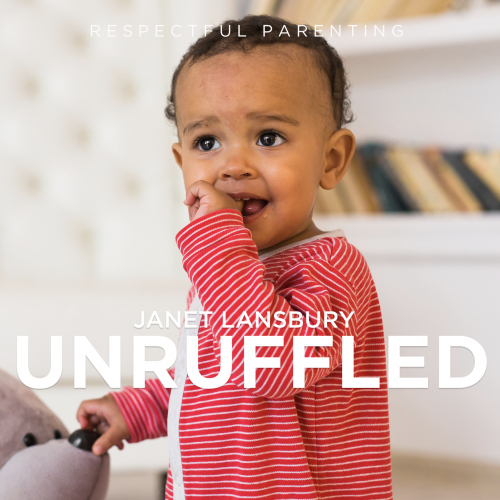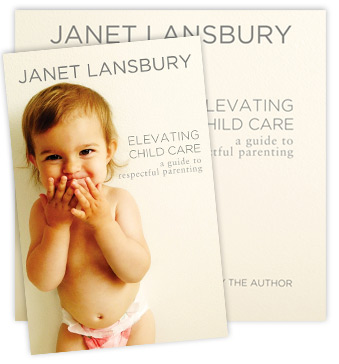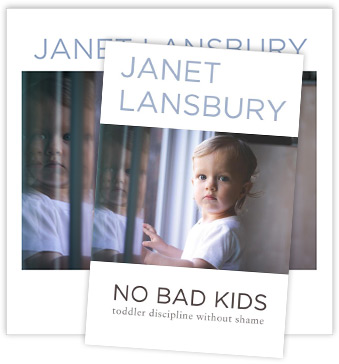In this episode: A mom writes to describe her 13-month-old’s first tantrum, saying that after several gentle and respectful attempts to manage the situation, she “froze and didn’t know what to do.” She’s wondering how she might have handled the situation differently so she can be better prepared for the inevitable ‘next time’.
Transcript of “Handling My Toddler’s First Tantrum”
Hi. This is Janet Lansbury and welcome to Unruffled. This week I’m going to be responding to a question from a parent who has just experienced her toddler’s first tantrum. She tried to remain calm and respectful, but was wondering if she might have handled the situation differently.
Before I begin, I want to remind everybody that both of my books, Elevating Child Care, and No Bad Kids: Toddler Discipline Without Shame, are available on audible.com and in paperback at Amazon and in eBook on Amazon, Barnes & Noble and apple.com. Also, episodes of my new audio series Sessions are available through my website. These are individual recordings of private consultations I’ve had with parents that agreed to be recorded. We discussed their urgent parenting issues, everything from setting limits with aggressive toddlers to effective leadership, tantrums and more. You can read complete descriptions of each episode and order individual episodes or for a very, very special price, order all of Volume One.
Here’s the note I received on my Facebook page:
“Hi, Janet. My 13-month-old had his first meltdown tantrum yesterday. He wanted to open the freezer and take things out. I let him look and touch a couple things, but told him we had to keep the door shut so the food can stay cold. I’ve been reading your posts and I spoke to him in a way which I thought was respectful and patient, letting him know I wasn’t just shutting the door and would let him explore for a moment. I tried to acknowledge his feelings.
Well, he didn’t like it. He started crying and arching his back. At this point, I took him to the living room, told him I was sorry he felt that way and tried to explain why we could not keep the freezer door open, and I understood he was upset, but he couldn’t play in the freezer anymore.
His crying and screaming was a lot louder than the voice I was using to talk to him, so I feel that he didn’t hear me. I also didn’t want to compete for his attention. He was also arching has back and pushing away from me, so I put him on the carpet on the floor and allowed him to carry on there, while rubbing his back and still trying to talk to him calmly.
At this point, I feel like I froze and didn’t know what to do anymore since he was crying over me trying to talk to him. Question is since this was our first meltdown/tantrum, how could I have handled it differently?”
Okay. Well first of all, welcome to toddlerhood. Tantrums and meltdowns are normal behavior. They make a lot of sense. They have so much going on internally at this age and this push-pull of, “Who am I? I want to assert myself more as my own person, but I really need this parent … These parents.” It’s a very tumultuous time of development. Frustration happens easily. Children are easily set off at this age. Yes, the first couple of times it happens, it can seem like, “What happened to our dear sweet baby that didn’t seem to have such intense reactions to things?” It is all okay. It is all developmentally appropriate. Children do pass through this stage.
What the studies also show is that really when children are in the eye of the storm in these situations, it’s best not to do much except to keep them safe and allow them to express the feelings, allow them to pass through these storms.
What can happen when we try to talk to our child is that our child gets another message. They might not even hear what we’re saying, but they feel our intention in talking to them. If our intention is anything other than, “I want to help you facilitate sharing these feelings with me and I’m here. I’m accepting your feelings. I’m allowing your feelings. I’m going to facilitate this happening.” If there’s any other kind of intention in us, then our child is likely to perceive it. That will make it harder for them to let these feelings flow as they need to.
While I do recommend what a lot of parenting advisors and experts recommend, acknowledging feelings, we have to be very careful in the way that we do that because acknowledging feelings … If we’re doing this to get our children to feel better more quickly, which I think some of us are more honest with ourselves in those moments, that might be part of our intention, if not all of our intention. If that is in the mix, then our child is going to know that and our child is going to feel like we are putting blocks up. We’re trying to dam up these feelings from happening.
Let’s go over the situation that this parent describes. He wanted to open the freezer and take things out. Okay, so this is a normal thing. Children are curious about everything at this age. They’re these amazing, amazing learners and they want to explore their environments and test everything out. He opens the freezer and he wants to take things out. She let him look and touch a couple of things, but then told him she had to keep the door shut so the food can stay cold. That all sounds wonderful. That’s exactly what I would do. I might also consider not giving my child free access to the kitchen, having a gate around the kitchen or what I call a “yes space” for children to play, which is a gated off room or section of a room that’s enclosed where we can go do something in the kitchen and not have to worry about our child being safe. Our child can in that environment be free to explore without us interrupting saying, “No, you can’t do this. I need to stop you from doing that.”
What this does is provides a very comfortable, relatively peaceful environment for both of us. We can be with our child in his space and be able to enjoy not having to interrupt and stop him from everything he’s doing and worry about that he’s going to get into something or be unsafe. We keep this room or this section of a room entirely safe, so that there are no “nos.” That’s why I call it a “yes space.” We don’t have to say, “No, no, no. Don’t do this. Don’t do that.” That encourages our child’s curiosity and exploration and also brings peace to us, both while we’re in the space with our child, enjoying their activities, not worrying, and also when we do have to leave our child there and focus on something else for a couple of minutes. We can know that our child is completely safe.
Our child might not always be thrilled to be there every moment, but we can finish up what we’re doing on the stove and check on our child, knowing that they are not going to be under our feet and having something, God forbid, spilled on them or somehow get hurt in the kitchen because we’re not able to supervise them.
That would be something I would strongly consider doing. The easiest way to do it is to do it much earlier, when a child is not even mobile yet. Then this gate is just established as part of their environment and they don’t question it and they don’t feel blocked off from anything.
If we establish it later, then we just have to deal with knowing that our child may say, “Hey, why are you stopping me from getting out of this room? I’m not so crazy about that idea.”
We have to be very confident and say, “I know you don’t like this idea. This is what’s good for our family. I’ve got to keep you safe and I’m going to do this, but it’s okay if you want to tell me you’re not happy with this. I want to hear that. I want to know everything you’re feeling. I’m okay with you disagreeing with me.”
Then she says she was respectful and patient, which is good. Patient, but not waiting for a child to completely stop on their own, because a lot of times, that’s not going to be able to happen. They’re not going to be able to stop without us being the ones to do it. Respectful, patient, but also feeling ourselves and the amount of time that we want to let them explore. It’s okay if that’s a very short time that we’re not comfortable with letting them take everything out. And know we have to put everything back. Or touch everything and let the freezer stay open and everything melts. We can have a time limit on that for ourselves.
Then being honest and saying, “Yeah. Actually, now I’m going to shut the door.” She said, “I tried to acknowledge his feelings.” That would be good. I would say, “Wow. Yeah, that’s really interesting in there. That’s cool you want to touch those things. Now I have to close the door. I know. Oh, shoot. You really wanted to do that.”
So being okay with him saying, “Hey, I don’t want you to shut the door on me.” Why would he want that? Now he’s also saying something very healthy here. He’s saying, “This is my will. This is what I want to do. You’re not letting me do what I want to do.” This part of him being more of a separate, independent person in this small toddler way.
It’s all good. It’s all positive. This is a very positive interaction, if we can approach it that way and believe that.
She says, “Well, he didn’t like it. He started crying and arching his back.” He’s having a strong reaction to this. He’s melting down about this. This has just set him off. Probably there’s other feelings being expressed here. That’s usually the case. All the frustrations of toddlerhood are being released through this one action. It’s probably not just about the stuff in the freezer. That set him off. Trusting that, trusting what seemed to be such overreactions to things.
Then she says, “He was arching his back. At this point, I took him to the living room and told him I was sorry he felt that way.”
Now she’s getting into a little bit of saying too much rather than really giving him the message, “Yeah, you have a right to get really upset about this. That’s okay. You’re allowed to feel this way and I’m okay with that.” Instead of giving him that message, she’s a little bit trying to talk him down, I feel like. She told him, “I was sorry he felt that way, tried to explain why he could not keep the freezer door open.” She’s going to a reasonable explanation. “Well see, you can’t because …” It’s gone way beyond reason at this point. It’s a fruitless pursuit, trying to explain so that he doesn’t feel what he’s feeling anymore.
What he’s saying is, “I just need to feel what I’m feeling. Just let me feel like this. Don’t try to talk me out of it. In the nicest possible way, don’t try to talk me out of it.” That’s the path she starts down there because, like all of us, it’s really hard to trust your child just being upset and having that be okay. I would recommend if she was going to do this differently that she really trust …
She takes him to a safe place. She lets him arch his back. If he’s not safe in her arms, then definitely place him down where he’s in a safe place and then really just be there. Let your shoulders drop, breathe, relax, trust. This is okay. He’s in the storm. It will pass. This is going to be a positive experience for him, knowing that it’s okay. You can fall apart and I’m there and I’m not going to try to stop you. You need to do this. I’m going to trust it and it’s okay to go to these places in yourself. You’re going to be all right.
The way to tell him that is not to tell him that, is to show him that by not trying to do anything about it. Just really allowing it to be.
Then she says that she told him, “I was sorry he felt this way,” and tried to explain why he could not keep the freezer door open. Again, I wouldn’t do that again. That one explanation in the beginning was perfect, simple, short. Then it let him have the feelings. Now from there, we’re not going to keep explaining our side of things. We’re really going to trust him to share his side.
Now she says, “I understood he was upset, but he couldn’t play in the freezer anymore.”
One of the reasons I chose this note to respond to in a podcast is that I’ve been hearing this a lot lately with parents saying, “I understand you’re upset.” I understand that that means the parent is following the advice that I give and many people give to acknowledge the feelings, which is wonderful, but that’s not really the way that you do that. Saying, “I understand you feel a certain way,” is not the same as saying, “Wow, I understand. I understand you feel da da da about so and so,” or, “I understand you’re upset.” It’s very distancing. Using “I understand” in that context is distancing. It’s not connecting. It’s saying, “Intellectually, I definitely understand that you’re upset and now I’ve said that. You can stop being upset.”
I think a lot of the times, that’s what we want to come of that if we’re honest with ourselves. To a child, that feels like we’re blowing off their feelings. It feels like we’re saying, “Okay, I get you. Now you can stop.” Again, that feels invalidating to a child. It feels like we’re trying to put the dam up for them and we’re not okay with them having this feeling, which means that they can’t feel safe with it either.
So, I’ve got a beef with this “I understand” thing. I think it works much better to say, “Wow. You’re really upset.” Look in his eyes and be able to be with him in that. Not that you’re going to be upset too, but be able to really receive that and not try to talk around it and not try to analyze it and explain it or anything. Just really be in the moment with him.
This is what connecting when correcting means or should mean. I don’t know if everybody means it this way, but this is what connecting really is. It’s being able to look in their eyes and see that they’re not happy with your choice and really allowing that to be okay.
So, it’s not about words very much, but if we are going to say something like “I understand,” it’s got to be looking in their eyes and nodding our head. “Oh, yeah. I understand. It’s so disappointing when I say no to you like that.” Really meaning it.
Then she says, “His crying and screaming was a lot louder than the voice I was using to talk to him.” Yes. That’s a good sign that she shouldn’t be talking to him there. Just nodding your head, just relaxing, just accepting. Letting it flow.
Then she says she didn’t want to compete for his attention, right? Don’t battle it. Don’t fight it. Just let it be.
“He was arching his back and pushing away from me, so I put him on the carpet on the floor and allowed him to carry on there while rubbing his back.”
Let him carry on. I don’t know about the rubbing his back. I would really try to tune in and just be available. Children will give you a sign of when they want closeness, that they want touch or they want to physically connect. It’s usually after they’re coming out of the storm and they’re calming down and they’re breathing and then they want to connect or snuggle or something like that possibly.
I really believe in trusting them and not pushing it. Not saying, “Oh, do you want a hug or anything?” Studies show that children, they feel our presence. We don’t need to keep reminding them, “I’m here. I want to hug you,” and all of those things. They feel our energy. They feel our presence. If we have this loving, accepting, trusting presence, that’s the best place that we can be with them. Then they will feel ready to come to us or let us know that they want us to come to them when they’re not in the eye of that storm. That’s what I would do differently.
She says, “At this point, I feel like I froze and didn’t know what to do anymore since he was crying over me trying to talk to him.” Yeah. Don’t try to do anything with it. Just let it happen.
“How could I have handled it differently?” I hope that what I’ve said helps you see how to really relax more and handle it in a more passive way, really. We don’t have to do anything. In fact, it’s better if we don’t to even let children know that we’re there. Children will know we’re there if we’re there. They’ll know that we’re there in a loving, accepting way if that’s the truth. It’s not something that we have to say to them.
I hope that helps. I’ve talked a lot about children and their feelings in my podcasts, so please check some of them out.
Again, thanks for listening. We can do this.















Experiencing our 14 month olds first tantrums lately, and I’ve been at a bit of a loss. This was a great breakdown of what a respectful response can look like. Thank you!
I’m so glad it helps. Thank you so much for sharing with me, Amy x